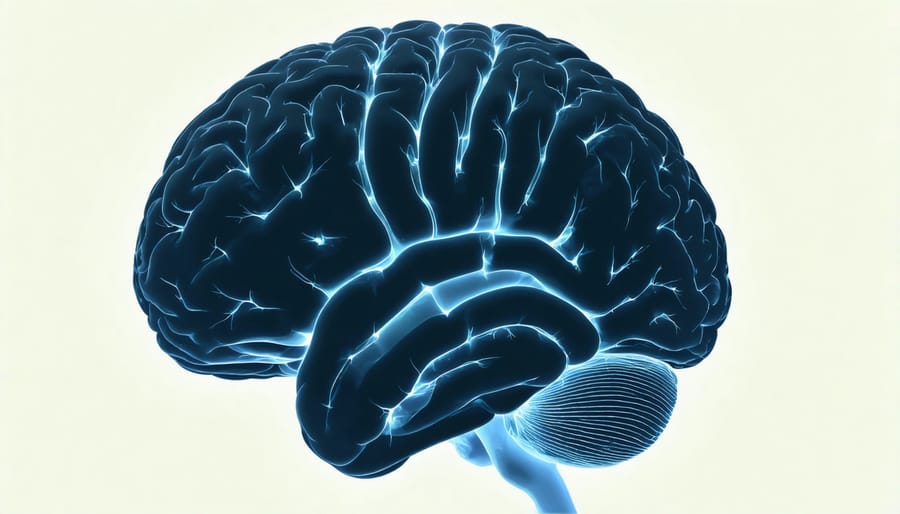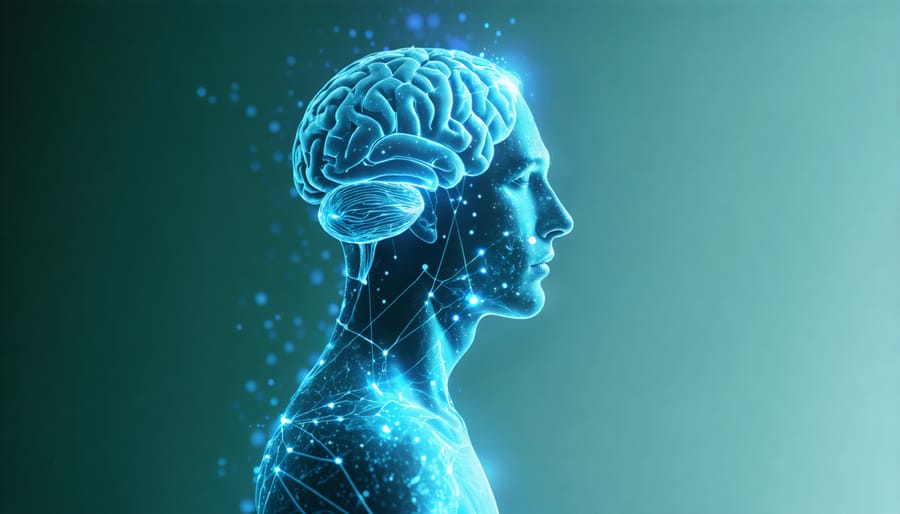The profound way your mind affects your body represents one of modern science’s most revolutionary discoveries. Every thought triggers a cascade of biological responses – from altered heart rhythms and hormone levels to changes in immune function and cellular repair. This mind-body connection explains why stress can manifest as physical symptoms like tension headaches or digestive issues, while positive mental states can enhance healing and resilience.
Recent neuroscience research reveals that this two-way communication between brain and body occurs through multiple pathways: the nervous system, endocrine system, and immune system all work in concert, translating mental experiences into physiological changes. Understanding this intricate relationship empowers us to leverage psychological techniques – from meditation to cognitive reframing – to positively influence our physical health.
For Canadians facing rising stress levels and chronic health challenges, this science offers hope: by developing greater awareness of the mind-body connection and practicing evidence-based techniques to manage our mental state, we can actively support our body’s natural healing abilities and build lasting resilience against life’s pressures.
The Science Behind Your Mind-Body Connection
Your Brain’s Stress Response System
When stress activates your brain’s alarm system, it sets off a remarkable chain of events throughout your body. The amygdala, your brain’s emotional center, recognizes potential threats and signals the hypothalamus to initiate the “fight-or-flight” response. This ancient survival mechanism helped our ancestors survive dangerous situations and continues to help us build stress resilience today.
During this response, your brain triggers the release of stress hormones like cortisol and adrenaline. These hormones cause immediate physical changes: your heart rate increases, breathing quickens, and muscles tense up. Blood flow shifts away from non-essential functions toward major muscle groups, preparing your body for action.
While this response is helpful in true emergencies, prolonged activation can impact your health. Your digestive system slows down, immune function may decrease, and sleep patterns can be disrupted. The good news is that your brain can also activate the relaxation response, which counteracts these effects.
Understanding this system helps you recognize when stress is affecting your body. When you feel your heart racing or muscles tensing, these are signals from your brain’s stress response system. By acknowledging these physical sensations, you can take steps to manage stress more effectively and maintain better overall health.

The Physical Impact of Mental Stress
When we experience mental stress, our bodies respond with a range of physical reactions that can affect multiple systems throughout our body. This mind-body connection becomes evident through various physical symptoms that many Canadians experience during stressful periods.
Common physical manifestations of stress include muscle tension, particularly in the neck and shoulders, headaches, and digestive issues such as stomach upset or changes in appetite. The stress hormone cortisol, released during challenging situations, can lead to increased heart rate, elevated blood pressure, and shallow breathing patterns.
Long-term stress can have even more significant impacts on our physical health. It may contribute to chronic conditions such as cardiovascular problems, weakened immune function, and disrupted sleep patterns. Many people also experience skin issues, including acne flare-ups or eczema, during periods of heightened stress.
The body’s stress response can create a cycle where physical symptoms cause additional worry, leading to more stress and worsening physical symptoms. Understanding this connection is crucial because it helps us recognize early warning signs and take appropriate action to manage our stress levels.
Research shows that when we address our mental stress through various coping strategies, these physical symptoms often improve or resolve completely. This demonstrates the powerful two-way relationship between our minds and bodies, and highlights the importance of taking a holistic approach to stress management.
Building Mental-Physical Resilience

Mindful Movement Practices
Movement-based practices offer powerful tools for managing stress and strengthening the mind-body connection. When we engage in mindful movement, we create a bridge between our physical sensations and mental state, helping to reduce anxiety and improve overall well-being.
Gentle exercises like yoga and tai chi are particularly effective at fostering mind-body awareness. These practices combine controlled breathing with slow, deliberate movements, helping practitioners develop better body awareness while calming the nervous system. Regular practice can lead to improved posture, reduced muscle tension, and enhanced emotional regulation.
Walking meditation, another accessible practice, involves paying careful attention to each step and bodily sensation while walking. This simple yet effective technique can be practiced anywhere, making it ideal for busy Canadians looking to incorporate mindfulness into their daily routines.
Progressive muscle relaxation (PMR) offers another approach to mindful movement. This technique involves systematically tensing and releasing different muscle groups while maintaining awareness of physical sensations. PMR can help identify areas of held tension and promote deep relaxation.
Even traditional exercise can become a mindful practice when approached with intention. Whether swimming, cycling, or strength training, focusing on form, breath, and bodily sensations transforms routine workouts into opportunities for mental clarity and stress relief.
To get started with mindful movement:
– Begin with 5-10 minutes of practice daily
– Choose activities that feel comfortable and enjoyable
– Pay attention to physical sensations without judgment
– Coordinate movement with breath
– Start slowly and gradually increase duration
Remember that consistency matters more than intensity when developing a mind-body practice.
Breathing and Relaxation Techniques
The practice of mindful breathing and relaxation techniques forms a crucial bridge between our mental and physical well-being. These breathing exercises for stress reduction can effectively activate your body’s natural relaxation response, lowering heart rate, blood pressure, and stress hormone levels.
One fundamental technique is diaphragmatic breathing, also known as belly breathing. Place one hand on your chest and the other on your belly. Breathe in slowly through your nose, allowing your belly to expand while keeping your chest relatively still. Exhale slowly through pursed lips, feeling your belly fall. Practice this for 5-10 breaths.
Progressive muscle relaxation offers another powerful approach. Starting from your toes and working up to your head, tense each muscle group for 5 seconds, then release for 10 seconds. This practice helps identify and release hidden tension in your body while promoting mental calm.
The 4-7-8 breathing technique, developed by Dr. Andrew Weil, involves inhaling for 4 counts, holding for 7, and exhaling for 8. This pattern helps regulate the nervous system and can be particularly effective before bed or during stressful moments.
Box breathing, used by military professionals and athletes, follows a simple pattern: inhale for 4 counts, hold for 4, exhale for 4, and hold for 4. This technique helps maintain focus and clarity while reducing stress.
Remember to practice these techniques regularly, even when you’re not feeling stressed. Like any skill, the mind-body connection strengthens with consistent practice, making these tools more effective when you need them most.
Nutrition for Mental-Physical Balance
The food choices we make daily play a crucial role in how our bodies and minds handle stress. Research shows that nutrition impacts stress resilience through multiple pathways, affecting both our psychological well-being and physical health.
A balanced diet rich in whole foods provides essential nutrients that support neurotransmitter production, helping regulate mood and stress responses. Omega-3 fatty acids, found in fatty fish, walnuts, and flaxseeds, are particularly important for brain health and can help reduce anxiety and depression symptoms. Complex carbohydrates from whole grains help maintain steady blood sugar levels, preventing mood swings and energy crashes that can amplify stress.
Antioxidant-rich fruits and vegetables protect both brain and body cells from stress-induced oxidative damage. Dark leafy greens, berries, and colorful vegetables contain compounds that support cognitive function and help maintain emotional balance. Adequate protein intake ensures a steady supply of amino acids necessary for producing stress-managing hormones and neurotransmitters.
Certain foods can actually increase stress vulnerability. Excessive caffeine, refined sugars, and processed foods may temporarily boost energy but often lead to increased anxiety and mood fluctuations. Regular consumption of these items can create a cycle of physical and emotional instability.
To optimize your mind-body balance through nutrition:
– Start your day with protein-rich breakfast
– Include colorful vegetables at every meal
– Choose whole grains over refined carbohydrates
– Stay hydrated with water throughout the day
– Limit processed foods and added sugars
– Consider fermented foods for gut health, which influences mood
Remember that consistency matters more than perfection. Small, sustainable changes to your diet can significantly improve your ability to handle both mental and physical stress over time.
Daily Habits for Long-term Resilience
Morning Routine for Mind-Body Health
Starting your day with intention can significantly strengthen your mind-body connection and set a positive tone for the hours ahead. A well-structured morning routine helps regulate stress hormones, boost mental clarity, and enhance physical well-being.
Begin by waking up at the same time each day to maintain your body’s natural circadian rhythm. Instead of immediately reaching for your phone, take three deep breaths while still in bed, focusing on the sensation of your breath moving through your body. This simple practice helps activate your parasympathetic nervous system, reducing stress from the start.
Gentle stretching or a 10-minute yoga session can help release physical tension and increase mental awareness. Pay attention to how your body feels as you move, noticing any areas of tightness or discomfort without judgment.
Consider incorporating mindful hydration by drinking a glass of water while focusing on the sensation of the liquid and its refreshing effects on your body. This practice combines physical nourishment with mental presence.
A brief morning meditation or gratitude practice can further strengthen the mind-body connection. Spend just 5-10 minutes sitting quietly, scanning your body for sensations while acknowledging three things you’re grateful for.
End your routine with a nourishing breakfast, eating slowly and mindfully. Notice the textures, temperatures, and flavours of your food, creating a conscious connection between your mind and body’s nutritional needs.

Stress-Proof Your Day
Start your day with a brief body scan meditation while still in bed, taking just two minutes to check in with how you’re feeling both mentally and physically. This simple practice sets a mindful tone for the day ahead.
Throughout your day, incorporate micro-breaks that support your mind-body balance. Set regular reminders to pause and take three deep breaths, especially before important meetings or challenging tasks. When you feel tension building, try progressive muscle relaxation by systematically tensing and releasing different muscle groups while sitting at your desk.
Make movement a natural part of your daily routine. Take short walking breaks, stretch during phone calls, or do gentle desk exercises. These physical activities help release stress hormones and promote mental clarity.
Practice mindful eating during meals by avoiding screens and focusing on the sensations, flavors, and textures of your food. This not only improves digestion but also creates a mental reset during busy days.
End your workday with a clear boundary ritual, such as changing clothes or taking a short walk, signaling to both mind and body that it’s time to transition to relaxation mode.
Before bed, spend five minutes writing down any lingering thoughts or concerns. This “brain dump” helps prevent nighttime stress and promotes better sleep quality, allowing your mind and body to properly recover for the next day.
The profound connection between our minds and bodies offers a powerful pathway to better health and well-being. Throughout this article, we’ve explored how our thoughts, emotions, and physical health are deeply intertwined, creating a complex system that influences our overall wellness. By understanding this relationship, we can take proactive steps to improve both our mental and physical health.
Remember that small changes can lead to significant improvements. Whether it’s practicing mindful breathing during stressful moments, incorporating regular physical activity into your daily routine, or paying attention to how your emotions affect your body, each step brings you closer to better health. The research is clear: when we care for our mental health, our bodies benefit, and when we nurture our physical health, our minds flourish.
Start by choosing one or two strategies discussed in this article that resonate with you the most. Perhaps begin with a short daily meditation practice or try progressive muscle relaxation before bed. As you become more comfortable with these techniques, gradually expand your mind-body practices.
Most importantly, be patient and kind with yourself as you develop these new habits. The mind-body connection is a powerful tool for transformation, but like any skill, it takes time and practice to strengthen. By making conscious choices to support both your mental and physical health, you’re investing in your overall well-being and creating a foundation for a healthier, more balanced life.

